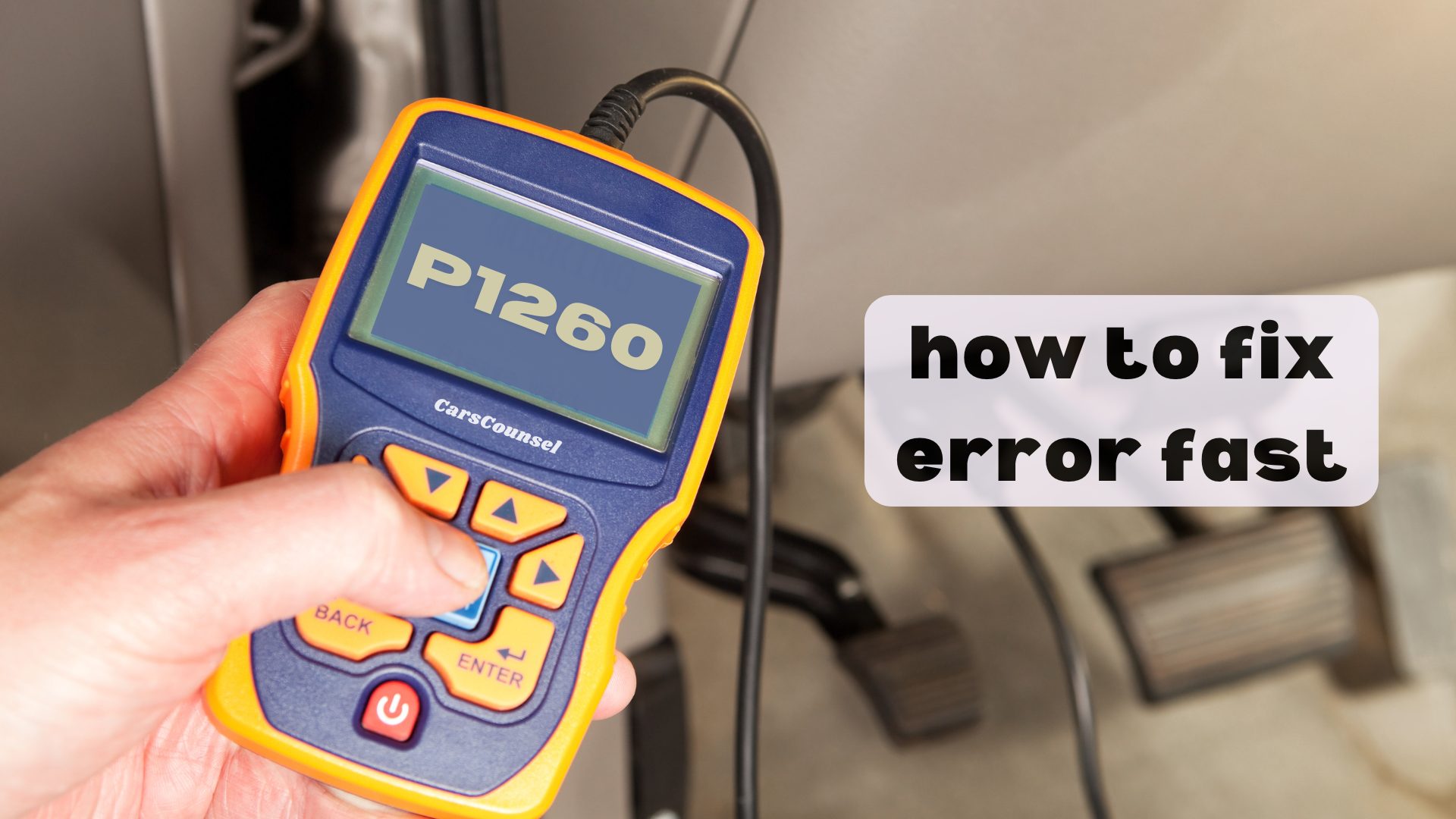What’s the first thing that comes to mind when you turn the key and your car refuses to start, leaving you stranded and helpless? It’s likely the dreaded P1260 code, a safeguard mechanism that immobilizes your vehicle to prevent theft or unauthorized use. But what triggers this code, and how do you get your car back on the road? Is it a faulty key, a wiring issue, or something more sinister?
The mystery begins to unravel as you investigate the underlying causes and symptoms of this code, and the solutions that will get you back behind the wheel.

Quick Navigation
Key Takeaways
- The P1260 code is triggered when the anti-theft system detects unauthorized access or tampering, immobilizing the vehicle to prevent theft or unauthorized use.
- Common causes of vehicle immobilization include faulty key or key fob, wiring issues, dead battery in the key fob, and faulty immobilizer module.
- Symptoms of P1260 code activation include struggle with startup, flashing security light, loss of power while driving, and immobilization effects persisting until the issue is resolved.
- To fix P1260 code issues, check for key cloning, inspect the ignition system, check wiring and connections, reset the anti-theft system, and reprogram affected keys or key fobs.
- Accurate diagnosis by a professional is crucial to identify the root cause of the problem and prevent further damage.
Code P1260 Description and Function
When your vehicle’s anti-theft system detects unauthorized access or tampering, it triggers the P1260 code, effectively immobilizing your vehicle to prevent theft or unauthorized use.
This error code is a security feature designed to protect your vehicle from potential thieves. Immobilization protocols are activated, preventing the engine from starting or the vehicle from being driven.
This is typically achieved by cutting off the fuel supply or ignition. The P1260 code is an essential component of your vehicle’s security system, ensuring that your vehicle remains safe and secure.
Common Causes of Vehicle Immobilization
The P1260 code can be triggered by a range of factors, from faulty components to attempted theft or tampering.
As a car owner, you’re likely concerned about the car security and immobilization methods that are in place to protect your vehicle.
- Faulty key or key fob: A malfunctioning key or key fob can trigger the P1260 code, immobilizing your vehicle.
- Wiring issues in the anti-theft system: Problems with the wiring can also lead to the code being triggered.
- Dead battery in the key fob: A dead battery in your key fob can prevent your car from starting, leading to immobilization.
- Faulty immobilizer module: A faulty immobilizer module can cause the P1260 code to be triggered, rendering your vehicle unusable.
Understanding these common causes can help you identify and address the issue quickly, getting your vehicle back on the road.
Symptoms of P1260 Code Activation
If your vehicle has triggered the P1260 code, you’ll likely experience some telltale signs that something is amiss.
You may struggle with startup, as the engine cranks but refuses to start. The security light on your dashboard will likely be flashing, indicating that the anti-theft system has been activated.
In some cases, you might experience a loss of power while driving, or the vehicle may start and then immediately shut off. These immobilization effects are designed to prevent the vehicle from being driven, and they’ll persist until the underlying issue is resolved.
Be prepared to address the problem promptly to get your vehicle back on the road.
How to Fix P1260 Code Issues
To get your vehicle up and running again, you’ll need to identify and address the underlying cause of the P1260 code.
This code is a security feature designed to prevent theft and unauthorized use, so it’s essential to take the necessary steps to resolve the issue.
- Check for key cloning: Guarantee that your key hasn’t been cloned or tampered with, which could be triggering the anti-theft system.
- Inspect the ignition system: Look for any signs of tampering or bypass attempts, which could be causing the immobilization.
- Check the wiring and connections: Verify that all wiring and connections related to the anti-theft system are secure and not damaged.
- Reset the anti-theft system: Once you’ve identified and addressed the underlying cause, confirm the system and reprogram any affected keys or key fobs.
Repair Cost Estimates and Diagnostic Fees
Your wallet is about to take a hit, as resolving the P1260 code issue comes with a price tag.
You’ll need to budget for repair estimates, which typically range from $100 to $500, depending on the extent of the problem.
Diagnostic charges will also apply, as a professional mechanic will need to identify the root cause of the issue. These fees vary depending on the shop’s rates and the time required to diagnose the problem.
Be prepared to pay extra for testing and inspecting the anti-theft system, key fob, and immobilizer module.
To get a more accurate estimate, consult with a trusted auto repair shop, and don’t forget to ask about any additional costs associated with resetting the anti-theft system and reprogramming your keys or key fobs.
Importance of Professional Diagnosis
While attempting to diagnose the P1260 code on your own may seem like a cost-effective solution, it can lead to further complications and even more expensive repairs down the line.
Without expert insight, you may misdiagnose the issue, causing more harm to your vehicle. Professional diagnosis is vital to identify the root cause of the problem.
- Accurate diagnosis: Professionals have the necessary diagnostic tools and expertise to pinpoint the exact issue.
- Time-saving: A professional can diagnose the issue quickly, saving you time and frustration.
- Prevents further damage: A misdiagnosis can lead to further damage, which a professional can prevent.
- Cost-effective: In the long run, a professional diagnosis can save you money by avoiding unnecessary repairs.
Resetting the Anti-Theft System
Security protocols dictate that the anti-theft system be reset when the P1260 code is triggered, ensuring the vehicle’s protection and preventing further unauthorized access.
You’ll need to reset the system to restore your vehicle’s functionality. This involves a System Reset, which will disable the immobilizer’s protective mode.
To do this, you’ll need to use an Immobilizer Bypass tool or consult your vehicle’s service manual for specific instructions. The reset process typically involves reprogramming the immobilizer module and re-synchronizing the key fob.
Once completed, your vehicle should start normally, and the P1260 code should be cleared. Remember to address the underlying cause of the code trigger to prevent future occurrences.
Additional Resources for Repair Guidance
When resetting the anti-theft system doesn’t resolve the P1260 code, it’s time to investigate alternative resources for repair guidance.
You’ll want to dig deeper to identify the root cause of the issue.
Here are some additional resources to help you fix the code:
- Factory manuals: Consult your vehicle’s factory service manual for specific guidance on troubleshooting and repairing the anti-theft system.
- Online forums: Research online forums dedicated to your vehicle’s make and model to see if other owners have experienced similar issues and how they resolved them.
- Repair databases: Utilize repair databases like ALLDATA or Autzone’s Repair Help to access detailed repair information and diagrams.
- Professional guidance: If you’re not comfortable with DIY repairs, consider consulting a professional mechanic who’s experience with your vehicle’s anti-theft system.
More OBD-II Codes
Conclusion
You’ve finally addressed the P1260 code issue and gotten your vehicle back on the road. Remember, a faulty anti-theft system can be more than just a nuisance – it’s a potential security risk. In fact, according to the National Insurance Crime Bureau, a vehicle is stolen every 40 seconds in the United States. By staying on top of your vehicle’s security system, you’re not only avoiding costly repairs, but also protecting your investment from theft.

